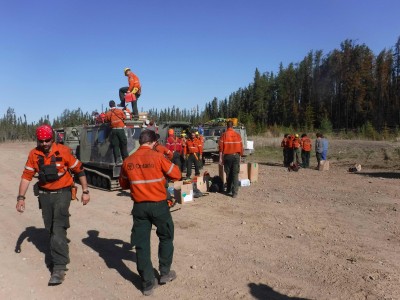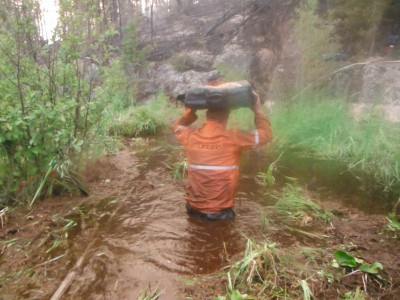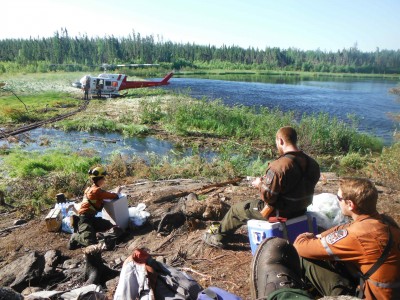 There’s something a little extra delicious about a barbequed meal and a cold beer on the deck after returning home from a fire-fighting tour. Our crew just finished a 19-day tour in Lac la Biche district in Alberta. We were working on a fire near Cold Lake that grew to 10 000 ha in less than 4 days in the absence of wind—it was dry, and the fuels were ready to burn. Fire behavior predictions foreshadowed lots of work, long days, and short sleeps.
There’s something a little extra delicious about a barbequed meal and a cold beer on the deck after returning home from a fire-fighting tour. Our crew just finished a 19-day tour in Lac la Biche district in Alberta. We were working on a fire near Cold Lake that grew to 10 000 ha in less than 4 days in the absence of wind—it was dry, and the fuels were ready to burn. Fire behavior predictions foreshadowed lots of work, long days, and short sleeps.
The Alberta government set up a base camp (trailers for a kitchen, diner, bathroom, logistics, radio ops, etc.), and we set up our tents. Everyday on tour is unpredictable—what you’ll see, what you’ll accomplish, when you’ll be going home. A small change in observed weather throughout the day can either increase or suppress fire behaviour, movement, and growth. Despite the abundant unknowns, I’m a creature of habit, and try to create as much of a daily routine as possible for the things I can control.
4:54 am: Alarm goes off.
5:15 am: Morning jog down the basecamp road
5:57 am: Wait in line for breakfast
5:59 am: Grab a bagged lunch
The bagged lunch. Of all the elements and difficulties you face on a daily basis while on tour, the bagged lunch can really be a morale booster or breaker. Looking in your bagged lunch before you get to the line can be destructive, because you KNOW there is going to be a white bread ham sandwich in there, and that’s a day-killer that you just don’t need at 6:00am (or if you’re “lucky”, it’ll be a white bread peanut butter and butter sandwich). It’s not wet feet, bug bites, sleep deprivation, or diminished cigarettes that warrant daily complaints; it’s the white bread ham sandwiches.
 On average, the bagged lunch consists of: 3 white bread ham, cheese, and butter sandwiches; one apple; one orange; one dessert square; two juice boxes; and, if you choose to grab one, a bag of chips. It might be immature. It might be selfish. But when you have a daily 30-minute walk through knee-deep muskeg to get to a 20-minute hike through dusty, sooty, burn, and your face is covered in black ash, your B.O. is unrecognizable, and your shin chafe starts to bleed, the last thing you want to pull out of your bagged lunch is a white bread ham sandwich.
On average, the bagged lunch consists of: 3 white bread ham, cheese, and butter sandwiches; one apple; one orange; one dessert square; two juice boxes; and, if you choose to grab one, a bag of chips. It might be immature. It might be selfish. But when you have a daily 30-minute walk through knee-deep muskeg to get to a 20-minute hike through dusty, sooty, burn, and your face is covered in black ash, your B.O. is unrecognizable, and your shin chafe starts to bleed, the last thing you want to pull out of your bagged lunch is a white bread ham sandwich.
By day 8, you’re pretty vocal about how much you hate sandwiches. By day 10, you’re pretty sure you cannot eat another sandwich. By day 14 you’ve boycotted sandwiches, and have started hoarding granola bars to get you through the day. Day 14. That’s two weeks.
 Let’s think about this for a minute. Ham, cheese, and butter sandwiches seem to be a fireline base-camp go to—why? Because they’re cheap and easy to make. When there are over 300 people to feed by a staff of 10, you can’t expect anything much fancier. Now think about northern semi-remote districts in Ontario, like Armstrong, or Pickle Lake, and the price of supporting over 200 rangers, where food prices are already outrageous for locals. Should the Ministry be responsible for supporting gourmet meals for the duration of rangers’ stay?
Let’s think about this for a minute. Ham, cheese, and butter sandwiches seem to be a fireline base-camp go to—why? Because they’re cheap and easy to make. When there are over 300 people to feed by a staff of 10, you can’t expect anything much fancier. Now think about northern semi-remote districts in Ontario, like Armstrong, or Pickle Lake, and the price of supporting over 200 rangers, where food prices are already outrageous for locals. Should the Ministry be responsible for supporting gourmet meals for the duration of rangers’ stay?
Food is expensive. Food preparation is timely. Exciting meal planning and development requires knowledge. Despite education, it’s surprising how quickly we become bored of eating the same, affordable meals all the time, and how quickly we become drawn to grabbing that bag of chips, or trying to score an extra dessert square. Food quickly becomes a comforting item on fire, as it is for so many people outside of fire.
We know that obesity rates are high among First Nations people. We know that food prices in remote communities are ridiculous. And so we know that the price and practicality to eat healthy is affecting obesity rates. But an underrepresented factor is the availability of variety. While we know that, yes, variety is limited and affects some remote and semi-remote areas, each day that I had a white bread ham sandwich, I was reminded how quickly you become bored of plain food, and how important it is to seek variety in order to continue making healthy choices.
 I am aware of the importance of fueling my body with healthy, hearty fuels, and so sometimes I have to remind myself to eat for the nutrients, not the comfort or enjoyment—but what happens when people aren’t as aware of the importance in making healthy decisions regularly? What about those who aren’t aware that they are making unhealthy decisions? What about those who don’t know what a healthy decision is? Considering all these questions, why on earth would someone continue to eat the white bread ham sandwich when they can grab an extra bag of BBQ chips, a Pepsi, and a dark chocolate Mounds bar every day instead?
I am aware of the importance of fueling my body with healthy, hearty fuels, and so sometimes I have to remind myself to eat for the nutrients, not the comfort or enjoyment—but what happens when people aren’t as aware of the importance in making healthy decisions regularly? What about those who aren’t aware that they are making unhealthy decisions? What about those who don’t know what a healthy decision is? Considering all these questions, why on earth would someone continue to eat the white bread ham sandwich when they can grab an extra bag of BBQ chips, a Pepsi, and a dark chocolate Mounds bar every day instead?
It’s important to realize that it’s not a divide; it’s not that First Nations people are always choosing unhealthy food options, and white people are saints when it comes to eating—trust me, I know that’s not true. But there’s a point to be made as we KNOW that food options are limited in northern remote and semi-remote communities, and that prices are high. If we want to truly make healthy options more available, it’s not enough to subsidize prices; it’s not enough to add more lettuce and peppers to the shelves. We need to revisit the importance of variety. Options. Explanations. Mentality. Being part of an individual’s built environment, improving overall diet is a complex task; not one that will ever have a simple answer or solution.
6:00am: Switch out 95% of my bagged lunch items with food I scavenged and stowed from dinner the night before.
6:03am: Get changed and gear up for the day
6:25am: Head to the bus, bagged lunch in hand, and get ready for another day’s work on LWF-122.
Author Ariel Root is currently in Kenora in her fourth season working as a forest fire fighter for the Ontario Ministry of Natural Resources and Forestry. She has a BSc in Food Science & Nutrition from Carleton University in 2012, and is currently a graduate student in the Health Science, Technology and Policy program at Carleton University. She has been featured on APTN’s new hit TV show, Playing with Fire, Season 2.
Come back for next week’s instalment.
Photos by Ariel Root
Follow us on twitter!